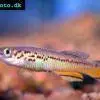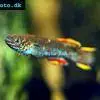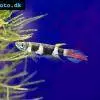Sixbar panchax - Epiplatys sexfasciatus
Scientific name: Epiplatys sexfasciatus
Common name: Sixbar panchax
Family: Nothobranchiidae
Usual size in fish tanks: 9 - 10 cm (3.54 - 3.94 inch)
014
Recommended pH range for the species: 5 - 7
Recommended water hardness (dGH): 4 - 12°N (71.43 - 214.29ppm)
0°C 32°F30°C 86°F
Recommended temperature: 20 - 27 °C (68 - 80.6°F)
The way how these fish reproduce: Spawning
Where the species comes from: Africa
Temperament to its own species: peaceful
Temperament toward other fish species: peaceful
Usual place in the tank: Middle levels
Origin
The Six-barred panchax are to be found on the African continent namely the largest populations are in Cameroon, Nigeria and Ghana where they inhabit the rivers along the coast.
Short description
As expected this fish gets its common name from the vertical barring that runs along the whole of it’s body length giving it quite a striking appearance. The six-barred panchax makes a great addition to any community set up as long as all of the species contained in the aquarium require the same water conditions. They are extremely peaceful but can be timid if kept in too small numbers. It is best to keep these in a small group of 6 specimens as this will give them more confidence and allow them to display their natural behaviour in the aquarium. Adult specimens will only reach an average length of between 3.25-3.5 inches making them ideal for smaller to medium aquariums. Most of the panchax species have been popular in the aquarium trade for many years thus making them readily available to most fish keepers. Like most fish species they do like good quality water so make sure that an aquarium maintenance schedule is performed to keep them at their healthiest.
Lifespan
If cared for correctly the average lifespan for the six-barred panchax is expected to be 6 years.
General care
As mentioned in the description section above these are not the largest of fish so do not require large aquariums. A group of these will need to be housed in an aquarium of at least 3 feet (90cm) in length, if kept in a large community set up then the aquarium size should be adjusted accordingly. They can be added to a planted tank if you wish but this is not necessary but to replicate their natural surroundings it is best to use sand for the substrate and and rocks or wood for decoration and to provide some hiding places if required. The water temperature should range between 20-27°C (68-81°F) and the pH should range between 5.0-7.0. As you can see these are quite wide ranges which does make this species a lot easier to care for than others. The Six-barred panchax should never be added to an immature set up and when they are acclimatised this should be done slowly to allow them to settle in quicker and reduce the risk of any shock. Regular water changes will be required and a suitable filtration system will be needed in the aquarium.
Feeding
These are not a difficult fish to feed and should accept all foods offered but they will require a varied diet. Use a commercial quality flake or small pellets for the staple diet but vary this with treats of live or frozen foods. Brine-shrimp and artemia are ideal.
Sexing
Mature males will display a brighter colouration compared to mature females and will have a larger body shape. The mature males will also develop extended finnage.
Breeding
The Six-barred panchax is not a difficult species to breed and often they will breed in the main aquarium without the keepers knowledge. If you wish to raise the fry it is best to use a separate breeding tank to give you more control and use an air driven sponge filter to allow you to adjust the water flow to a reasonable level.Spawning mops or floating plants should be added to the breeding tank and it is best to add two females for each male involved.
If the parent fish are conditioned well it will not take them long to spawn but they will eat the eggs if the mops or plants are not removed and placed in a separate growing on tank. The eggs will hatch after 2 weeks and once free swimming the fry can be fed on infusoria until they have grown large enough to accept newly hatched brine shrimp.



 Lyretail
Lyretail  Splendid
Splendid  Redchin
Redchin  Panchax
Panchax  Amiets
Amiets  Blue
Blue  Blue
Blue  Guenthers
Guenthers  Banded
Banded